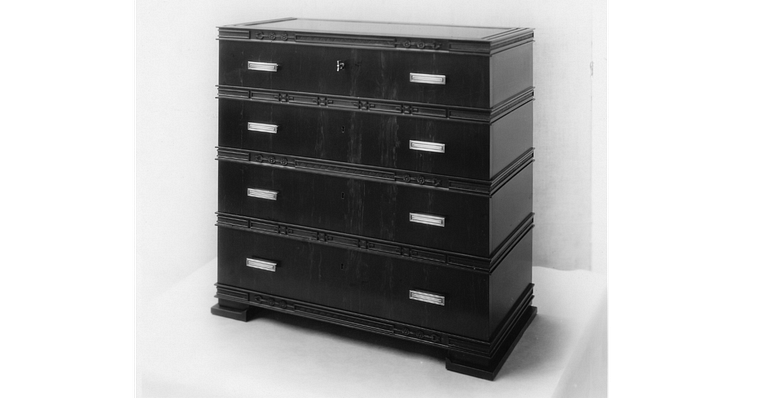Axel Einar Hjorth
a macassar ebony chest of drawers, Nordiska Kompaniet, 1928, exhibited at the World's Fair in Barcelona 1929.
Alva & Gunnar Myrdal Collection. Macassar ebony, borders with stylized relief decoration, four drawers with silver plated handles, maker's metal label. The Nordiska Kompaniet's metal label with the number C21433 implies that this actual piece was executed to be included in the Barcelona Exhibition. 80 x 42 cm, height 80 cm. Key included.
Minor damages and wear. Keys included.
Provenance
Alva & Gunnar Myrdal. Thence by descent.
Exhibitions
The World's Fair in Barcelona 1929.
Literature
Christian Björk, Thomas Ekström, Eric Ericson, "Axel Einar Hjorth Möbelarkitekt", Signum Lund 2009, pp 82-83.
Otto Schulz, "Tidskriften Boet" 1929. This chest of drawers depicted p 123.
Compare the chest of drawers by Hjorth executed in 1931 and sold at Bukowskis auction 539, April 2006, lot nr 1318, a slightly larger version without the silver plated handles as seen on this chest of drawers from the Barcelona exhibition.
More information
The 1929 Barcelona International Exposition, officially in Spanish: Exposición Internacional de Barcelona 1929, it took place from 20 May 1929 to 15 January 1930 in Barcelona, Spain.
The Magic Fountain of Montjuïc, designed by Carles Buïgas was built ahead of the exhibition and is still today a landmark for Barcelona.
The Swedish Pavillion was designed by Peder Clason and most remarkable was probably the tower, symbolizing a lighthouse, "Funkis" standing outside the Pavillion.
The Barcelona Exhibition was the first major exhibition for Axel Einar Hjorth as the head of the Nordiska Kompaniet furniture department. The Nordiska Kompaniet's exhibition area, also designed by Hjorth seems to have been remarkable with its deep blueish grey walls, black floorings where the spectacular pieces of furniture in black, grey, red and gold created impressive effects. The cabinet 'Louis' was included in the Swedish Pavillion in Barcelona. Louis was sold by Bukowski's in April 2002 for 1,150,000 sek a record price for a 20thC Swedish piece of furniture that it took almost 20 years to beat.
The present pieces disappeared from the public eye post the exhibition. The magnificent tabouret which is to be seen in the blurred photographs from the exhibition was rediscovered not too long ago at a smaller market in Barcelona.
The tabouret has few similarities to other pieces by Hjorth. He managed to blend the Swedish classicism with French Art Déco and turn it into a unique solitary piece of furniture.
This applies also to the macassar-ebony veneered chest of drawers, it has a solemn appearance highlighted with the discreet wood carvings and its silver plated handles. The chest of drawers has only been seen in a black and white photograph and as a pencil drawing from the archives. How it came to the Myrdal family is yet to be discovered.
Family anecdote:
"The black chest of drawers is primarily remembered from standing in Alva's bedroom. On top of it Alva used to keep a pewter bowl with dried rose petals, as a pot-pourri. In the upper drawer Alva kept her gloves, her purses with the different currencies neatly organised, in the second drawer she kept her handbags and evening bags ( for instance the ones included in this auction). In the bottom drawer she kept 'give-aways' often something from her frequent trips, such as handkerchiefs, little brooches, poetry books etc".
Designer
Axel Einar Hjorth is considered one of Sweden's most significant furniture designers during the 1920s and 30s. Hjorth's early employers included Svenska Möbelfabrikerna in Bodafors and the Stockholm Crafts Association. The big breakthrough came as chief architect for Nordiska Kompaniet, a position he took up in 1927 and held until 1938. Hjorth's first major assignment was the Nordiska Kompaniet's lavish stand at the World Exhibition in Barcelona in 1929, to then participate in several major international exhibitions during the following decade. In 1929, Hjorth also breaks new ground and designs the first series of rustic furniture in stained pine, the so-called sports cabin furniture that was named "Lovö", "Utö" and "Sandhamn" after the islands in the Stockholm archipelago.
Read more






















































































































